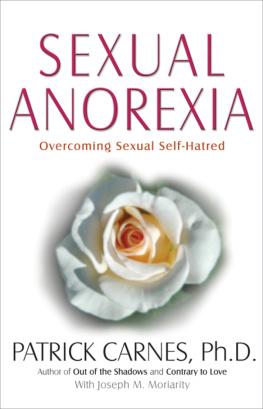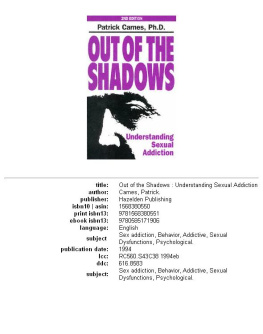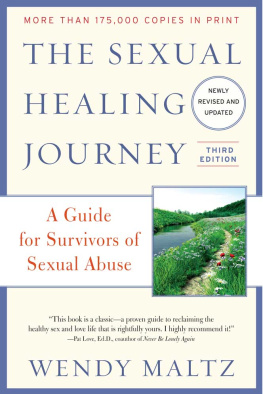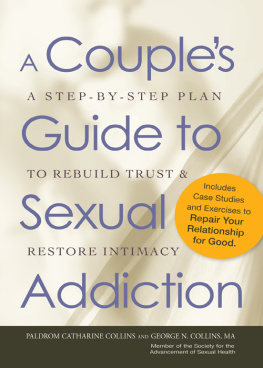Half Title
SEXUAL ANOREXIA
In Sexual Anorexia: Overcoming Sexual Self-Hatred, Patrick Carnes explores more of the continuum of human sexual dysfunction. With all the moral injunctions about sex that most of us received during childhood, it is difficult to see a lack of, or even revulsion of, sexual desire as a serious problem. In comparing these areas of difficulty with the anorexic and bulimic eating disorders, Carnes masterfully presents an easily understood structure of the disease process and a recovery regime that offers real hope for comfort in relationships.
Pia Mellody, R.N., addictions and codependence consultant, author of Facing Codependence, Breaking Free, and Facing Love Addiction
A valuable resource for men and women who have been afraid and confused about sex. Patrick Carnes has made another remarkable contribution that fosters sexual recovery and sexual healing. Using his trademark blend of wisdom, practical strategies, and personal stories, Carnes takes readers through a step-by-step program to discover the meaning and joys of healthy sexual intimacy.
Wendy Maltz, M.S.W., sex therapist, author of The Sexual Healing Journey and co-author of In the Garden of Desire
Title

Patrick Carnes, Ph.D.
with Joseph M. Moriarity
Copyright
Hazelden Publishing
Center City, Minnesota 55012-0176
800-328-9000
hazelden.org/bookstore
1997 by Patrick Carnes. Printed in the United States of America. No
portion of this publication may be reproduced in any manner without
the written permission of the publisher
Library of Congress Cataloging-in-Publication Data
Carnes, Patrick, 1994
Sexual anorexia: overcoming sexual self-hatred/Patrick Carnes.
p. cm.
Includes bibliographical references and index.
ISBN 1-56838-144-1
E-book ISBN: 978-1-59285-764-7
1. Sexual aversion disorders. I. Title.
RC560.S45C37 1997
616.8583dc21
97-12610
CIP
0 0 9 9 9 8 9 7 6 5 4 3 2 1
Book design by Nora Koch/Gravel Pit Publications
Cover design by David Spohn
Typesetting by Nora Koch/Gravel Pit Publications
Editors note
Hazelden offers a variety of information on chemical dependency and related areas. Our publications do not necessarily represent Hazeldens programs, nor do they officially speak for any Twelve Step organization.
All the stories in this book are based on actual experiences. The names and details have been changed to protect the privacy of the people involved. In some cases, composites have been created.
The Twelve Steps are reprinted with permission of Alcoholics Anonymous World Services, Inc. Permission to reprint and adapt the Twelve Steps does not mean that AA has reviewed or approved the contents of this publication, nor that AA agrees with the views expressed herein. AA is a program of recovery from alcoholism onlyuse of the Twelve Steps in connection with programs and activities which are patterned after AA, but which address other problems, or in any other non-AA context, does not imply otherwise.
Dedication
This book is dedicated to the couples who participate in Recovering Couples Anonymous.
Contents
CONTENTS
Introduction
Chapter 5: Sex as Health
Chapter 17: Passion
Appendix A: The Twelve Dimensions, Strategies, and Principles of Healthy Sexuality
The Twelve Suggested Steps of Sexual Compulsives Anonymous
List of Illustrations
Preface
Preface
In many ways, this book began in 1983 when I completed Out of the Shadows: Understanding Sexual Addiction. That book described the nature of sexual addiction and the path of recovery from the illness. Yet I knew even then that Out of the Shadows told only part of the story. From that point on, I tried to define sexual addiction as part of a continuum. On one end were people who had lost the ability to regulate their own sexual behavior. On the other extreme were those who could not force themselves to be sexual without dire internal consequences. The two conditions were related. Both obsessional states drew their power from a deep sexual self-hatred.
In 1989, I completed Contrary to Love, which described sexual addiction for professionals. The book began with the continuum of compulsive sex and compulsive nonsex. It also described in detail how sex addicts go through periods of deescalation in which sex becomes the enemy. The whole process of therapy and recovery is directed toward sexual health, which at that point I only partly dened.
Since then, we have witnessed a decade of extraordinary progress. Twelve Step groups for sexual addiction, such as Sex and Love Addicts Anonymous, Sexaholics Anonymous, Sex Addicts Anonymous, and Sexual Compulsives Anonymous, have ourished across the country and throughout the world. The National Council on Sexual Addiction and Compulsivity is in its fourth year of publishing a medical journal dedicated to the problem. Inpatient and outpatient programs for sexual addiction have sprung up across the nation. In 1997, three basic medical texts included chapters on sexual addiction.
In the midst of rapidly expanding awareness about sexual addiction, a growing consciousness about what I call sexual anorexia has also emergedalbeit more slowly. Twelve Step groups held conferences, published literature, and offered groups to sexual anorexics. The concern was more tentative for sexual anorexia, however, in part because the losses are more hidden. But professionals began to note the connections between sexual acting out and acting in. Those who researched abuse, especially sexual abuse, wrote about traumatic abstinence. Sexologists separated sexual aversion as a more extreme problem than sexual dysfunction. And like the addiction specialists, they now acknowledged a continuum of extremes. Yet no one book dened the problem for those seeking recovery using a Twelve Step format. There was no Out of the Shadows for the sexual anorexic.
Another problem also started to reveal itself. As I traveled and spoke about recovery, I heard many people ask, What is healthy sexuality? In 1991, I wrote more about that in DontCall It Love, wherein I described eight dimensions of healthy sexuality. These specic dimensions grew out of the research for that book, which involved interviewing over one thousand recovering sex addicts and their partners. I used the model of the eight dimensions in my speeches and workshops. In one such workshop, it dawned on me that the workshop participants already possessed the tools for understanding what it was they sought. Those tools were the very Twelve Step principles with which they were already familiar in other contexts. Recovering people simply needed to know that they could apply their Twelve Step skills to their sexuality. When I spoke around the country, I could see how helpful making that bridge was. People started to use the materials, and soon Sexual Anorexia: Overcoming Sexual Self-Hatred started to take form. Once I realized how the principles of the Twelve Steps paralleled the dimensions of healthy sexuality, I expanded the latter from eight to twelve. A matrix matching the (now) twelve dimensions with twelve supportive strategies for achieving them and the applicable principles of the Twelve Steps can be found in . This matrix provides a quick overview of what this book hopes to accomplish and how to get there.











